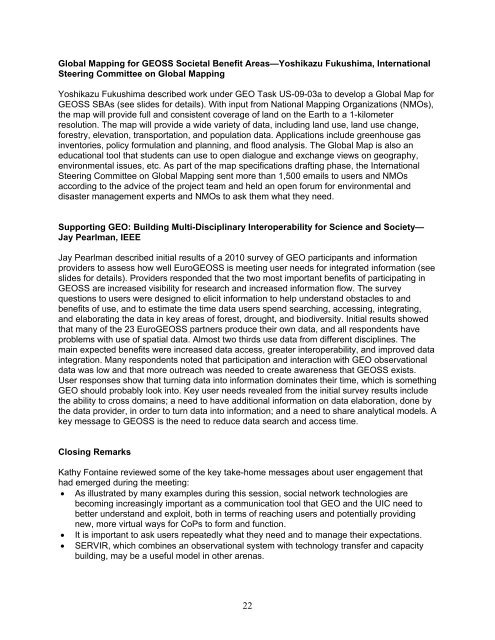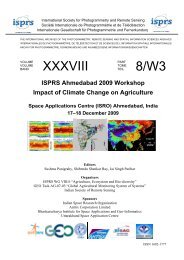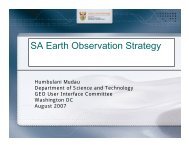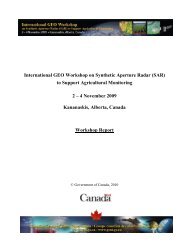GEO UIC Committee: - Group on Earth Observations
GEO UIC Committee: - Group on Earth Observations
GEO UIC Committee: - Group on Earth Observations
Create successful ePaper yourself
Turn your PDF publications into a flip-book with our unique Google optimized e-Paper software.
Global Mapping for <str<strong>on</strong>g>GEO</str<strong>on</strong>g>SS Societal Benefit Areas—Yoshikazu Fukushima, Internati<strong>on</strong>al<br />
Steering <str<strong>on</strong>g>Committee</str<strong>on</strong>g> <strong>on</strong> Global Mapping<br />
Yoshikazu Fukushima described work under <str<strong>on</strong>g>GEO</str<strong>on</strong>g> Task US-09-03a to develop a Global Map for<br />
<str<strong>on</strong>g>GEO</str<strong>on</strong>g>SS SBAs (see slides for details). With input from Nati<strong>on</strong>al Mapping Organizati<strong>on</strong>s (NMOs),<br />
the map will provide full and c<strong>on</strong>sistent coverage of land <strong>on</strong> the <strong>Earth</strong> to a 1-kilometer<br />
resoluti<strong>on</strong>. The map will provide a wide variety of data, including land use, land use change,<br />
forestry, elevati<strong>on</strong>, transportati<strong>on</strong>, and populati<strong>on</strong> data. Applicati<strong>on</strong>s include greenhouse gas<br />
inventories, policy formulati<strong>on</strong> and planning, and flood analysis. The Global Map is also an<br />
educati<strong>on</strong>al tool that students can use to open dialogue and exchange views <strong>on</strong> geography,<br />
envir<strong>on</strong>mental issues, etc. As part of the map specificati<strong>on</strong>s drafting phase, the Internati<strong>on</strong>al<br />
Steering <str<strong>on</strong>g>Committee</str<strong>on</strong>g> <strong>on</strong> Global Mapping sent more than 1,500 emails to users and NMOs<br />
according to the advice of the project team and held an open forum for envir<strong>on</strong>mental and<br />
disaster management experts and NMOs to ask them what they need.<br />
Supporting <str<strong>on</strong>g>GEO</str<strong>on</strong>g>: Building Multi-Disciplinary Interoperability for Science and Society—<br />
Jay Pearlman, IEEE<br />
Jay Pearlman described initial results of a 2010 survey of <str<strong>on</strong>g>GEO</str<strong>on</strong>g> participants and informati<strong>on</strong><br />
providers to assess how well Euro<str<strong>on</strong>g>GEO</str<strong>on</strong>g>SS is meeting user needs for integrated informati<strong>on</strong> (see<br />
slides for details). Providers resp<strong>on</strong>ded that the two most important benefits of participating in<br />
<str<strong>on</strong>g>GEO</str<strong>on</strong>g>SS are increased visibility for research and increased informati<strong>on</strong> flow. The survey<br />
questi<strong>on</strong>s to users were designed to elicit informati<strong>on</strong> to help understand obstacles to and<br />
benefits of use, and to estimate the time data users spend searching, accessing, integrating,<br />
and elaborating the data in key areas of forest, drought, and biodiversity. Initial results showed<br />
that many of the 23 Euro<str<strong>on</strong>g>GEO</str<strong>on</strong>g>SS partners produce their own data, and all resp<strong>on</strong>dents have<br />
problems with use of spatial data. Almost two thirds use data from different disciplines. The<br />
main expected benefits were increased data access, greater interoperability, and improved data<br />
integrati<strong>on</strong>. Many resp<strong>on</strong>dents noted that participati<strong>on</strong> and interacti<strong>on</strong> with <str<strong>on</strong>g>GEO</str<strong>on</strong>g> observati<strong>on</strong>al<br />
data was low and that more outreach was needed to create awareness that <str<strong>on</strong>g>GEO</str<strong>on</strong>g>SS exists.<br />
User resp<strong>on</strong>ses show that turning data into informati<strong>on</strong> dominates their time, which is something<br />
<str<strong>on</strong>g>GEO</str<strong>on</strong>g> should probably look into. Key user needs revealed from the initial survey results include<br />
the ability to cross domains; a need to have additi<strong>on</strong>al informati<strong>on</strong> <strong>on</strong> data elaborati<strong>on</strong>, d<strong>on</strong>e by<br />
the data provider, in order to turn data into informati<strong>on</strong>; and a need to share analytical models. A<br />
key message to <str<strong>on</strong>g>GEO</str<strong>on</strong>g>SS is the need to reduce data search and access time.<br />
Closing Remarks<br />
Kathy F<strong>on</strong>taine reviewed some of the key take-home messages about user engagement that<br />
had emerged during the meeting:<br />
• As illustrated by many examples during this sessi<strong>on</strong>, social network technologies are<br />
becoming increasingly important as a communicati<strong>on</strong> tool that <str<strong>on</strong>g>GEO</str<strong>on</strong>g> and the <str<strong>on</strong>g>UIC</str<strong>on</strong>g> need to<br />
better understand and exploit, both in terms of reaching users and potentially providing<br />
new, more virtual ways for CoPs to form and functi<strong>on</strong>.<br />
• It is important to ask users repeatedly what they need and to manage their expectati<strong>on</strong>s.<br />
• SERVIR, which combines an observati<strong>on</strong>al system with technology transfer and capacity<br />
building, may be a useful model in other arenas.<br />
22







